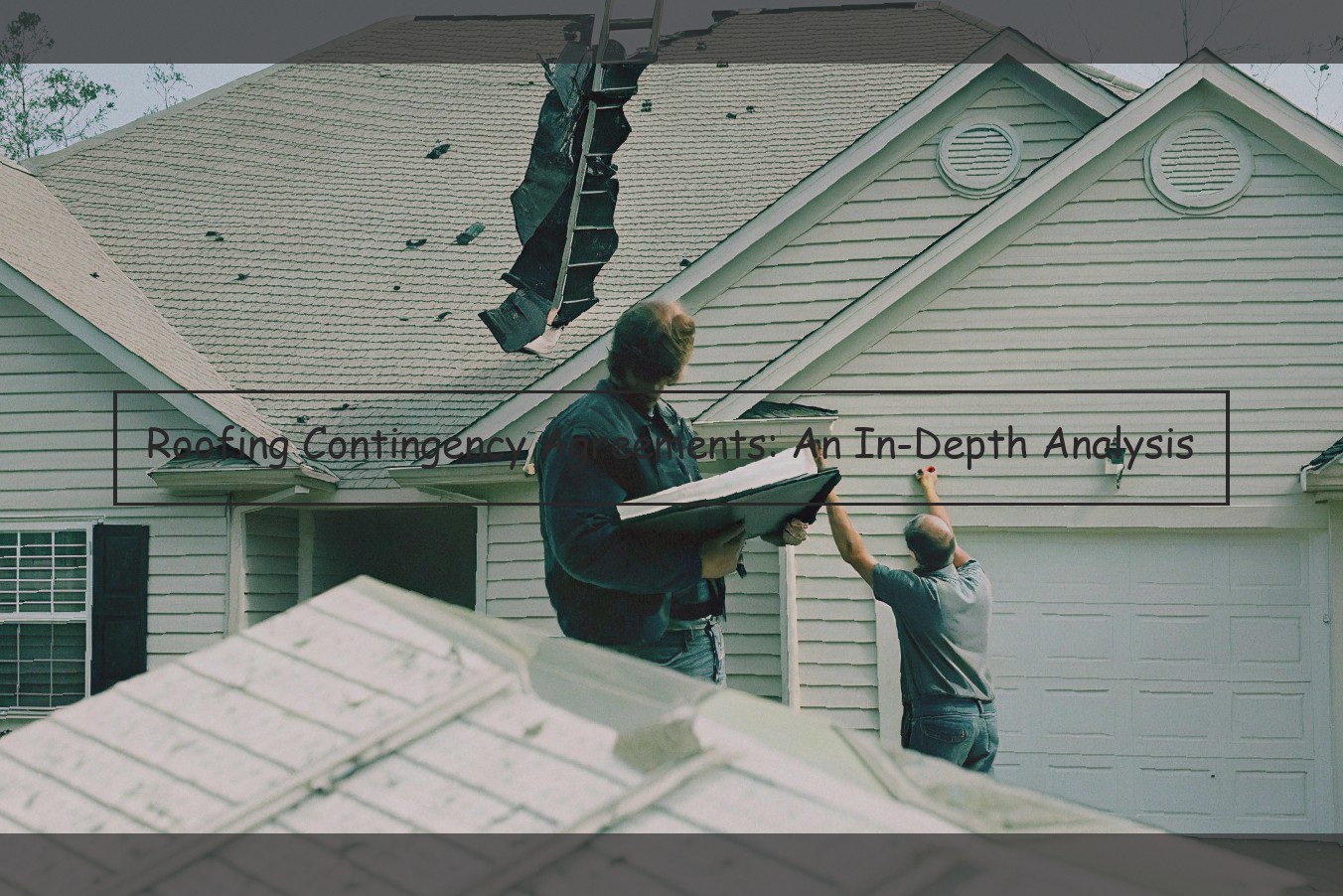
Roofing Contingency Agreement Defined
A roofing contingency agreement, also known as a contingency agreement for a roof, is a binding agreement between a homeowner and a roofing contractor or company that establishes the terms and conditions for roof repair, replacement, or installation after it has been determined that there is a need to repair or replace the residential roof. It will often be used after a thorough inspection of the roof by a qualified contractor that reveals extensive damage to the roof surface, sheathing layers , or other components of the roofing system.
A roofing contingency agreement may be necessary if it has been determined that the project scope involves a complete roofing replacement to be performed if the owner’s insurance carrier issues a payment for a claim or payment becomes due for costs incurred due to an act of nature or unexpected deterioration of the roof materials that requires the roof to be replaced to ensure appropriate weather protection for the dwelling.
Roofing contingency agreements are often used when a homeowner does not have sufficient funds on hand to pay for the cost to repair or replace the roofing system but does have a reasonable expectation that the work will be funded through insurance proceeds, warranty claims, or through loans or other financing arrangements. In most cases, homeowners do not have the financial resources available to pay for a new roof out of their own personal funds, but there is a reasonably high likelihood that the roof will be stealth funded. In those cases, contingency contracts are of significant value to homeowners. Contingency agreements are not contracts of sale and do not require financing to purchase the services of a contractor.
Why Roofing Contingency Agreements Matter
Both homeowners and contractors have an interest in using a roofing contingency agreement. For the homeowner, the agreement allows them to establish a clear and organized method of paying for the repair or replacement costs of their roof. It also provides them a way of protecting their investment. A contractor uses this agreement to protect themselves. The agreement allows them to focus their time and efforts on repairing or replacing the roof without worrying about whether they have a job lined up and how they will be paid if they do not.
There must be a written agreement to make roof replacement contingent upon receiving insurance proceeds even if the roof needs to be replaced because of a covered peril. A contractor’s lien can be placed on the property if they are not properly paid. This can interfere with the sale of the property causing the homeowner to lose money. The contractor themselves will also be adversely affected because if the landowner files for bankruptcy, then the contractor’s lien will need to be resolved as part of the bankruptcy litigation.
Key Components of a Roofing Contingency Agreement
One of the most important parts of a contract for a roofing deal is the contingency agreement. The contingency agreement is not to be confused with the work to be done. The contingency agreement is different.
Often a roofing contractor will have a contingency agreement with a homeowner to provide a roof. The homeowner often has a similar contingency agreement with an insurance company or other third party. Regardless, the contingency agreement should contain certain requirements as seen below.
The contingency should require the parties to the contingency to close on the roof on a specified date.
The contingency should require the roof to be closed if the roof is approved by the insurance company or other third party. Sometimes a contingency agreement is entered between the contractor and the homeowner to protect the contractor. When that is the case, the contingency should require that the roof be approved by the insurance company or other third party or the deal is off.
Most contingency agreements enter into the doctrine of specific performance. In order for specific performance to apply, there must be a specific object (the roof), meeting in all respects the terms of the contract, and a valid contract that can be enforced.
A specific object may be meeting all the terms of the contract but sometimes a homeowner may require that the roofing contractor do some type of work to the roof such as a repair before the roof can be put on. Depending on the state law from which the contingency agreement is entered, the law may find that the contractor put on notice. However, if the homeowner provides for the roof to be closed and the contractor notices that the roof before the new roof was put on was in poor shape or deteriorated, it may be best to provide for specific performance in the contingency.
A good contingency will make a distinction between property damage to the building or home. Property damage will allow for specific performance by the roof contractor. But damage to the roof itself usually will not allow for specific performance. Specific performance may be available although in most contracts, roof contractors will find specific performance to be too high of a bar and seek other terms.
Deciphering a Roofing Contingency Agreement PDF
When it comes to reading a roofing contingency agreement in PDF format, it is important for individuals to first familiarize themselves with the essential components of the contract. Some key elements to look out for include the type of work to be done, the agreed upon price between the contractor and the property owner, and the timeframe for completion of the project. Experts recommend to carefully review all roofing documents before making a commitment, especially when it comes to agreeing upon a specific price or expectation and signing the contract, as it can be difficult to make changes or adjust the terms of the agreement once it is in writing.
In order to make sure that all important information has been reviewed thoroughly, homeowners are encouraged to highlight or underline key details of the contract and make notes in the margin. They can also revisited the contract periodically to check for any mistakes or areas that they may have missed during the initial review process.
When looking at terminology within the roofing contract, it is important to not get lost in the legal jargon. In addition to the key elements mentioned above, individuals reading roofing contracts are encouraged to look out for words such as conditions precedent (which means that something must happen before the parties are obligated to carry out their agreement) and material alteration (which means that an alteration in the outcome of the roofing project must be substantial enough to warrant a discussion between the involved parties).
Common Issues with Roofing Contingency Agreements
Even with the many benefits offered by a roofing contingency agreement, there are several common pitfalls that homeowners and contractors fall into when using them. If you’re looking into using a roofing contingency agreement or have been using them without seeing the success you were hoping for, look over this list to see if you’re making any of the following mistakes.
Not re-evaluating the agreement after every storm or hail event – After every storm or hail event, your roofing contingency agreement should be re-evaluated and updated. Leaving it the same leaves you open to exposure. Just because a storm hit, doesn’t mean it necessarily affected the roofing contract specified in the agreement. A re-evaluation is always necessary to confirm whether a roofing agreement is still current .
Failing to include details on the construction project – Your roofing contingency agreement should contain specific details on the construction project. How detailed depends on general building laws and the size of the project. Any changes to or additions of materials and equipment should also be listed so that all parties clearly know what is included in the agreement.
Not listing other relevant documents – In addition to including details of the contract, make sure you include any other relevant documents. For general building projects, this includes the agreement to arbitrate, notice of violations, the sale of property and appraisal of the real estate. But for smaller projects, additional documents are usually unnecessary.
Failing to include delay damages – Generally, it is customary for builders to include a delay damage clause in a contingency agreement. If the builder fails to specify damages, damages may not be enforceable.
How to Draft a Roofing Contingency Agreement
With the understanding of what a roofing contingency agreement is, it is important to be familiar with the steps to create such agreement. When drafting a roofing contingency agreement, it is important to follow these steps:
First, the posting of the Contingency Agreement should clearly state the following: that the Contingency Agreement is subject to a specified condition precedent, e.g., insurance proceeds, and the time frame in which it is applicable. As an example, a contingency agreement might state the following: this agreement is contingent upon the receipt of payment from the insurance company for all or part of the cost of repairs and/or replacement of the roof, siding, windows, or other portions of the home, which damage or destruction is the result of a storm on [insert date of storm, if available]. Further, the Contingency Agreement should state that the agreement is automatically cancelled within a specified time frame, e.g., ten (10) days from the date of the agreement.
Second, as with almost any contract, if it is not written clearly, there will likely be ambiguity. A contingency agreement should be as clear as possible, and all terms should be defined plainly on the agreement. If any term is vague, there will be a higher risk of misunderstanding, confusion, or even litigation.
Third, either public adjusters or contractors should take caution when using a roof specialist or contractor. Many roof specialists or contractors "advertise" that they are roof specialists or roof contractors, but they are actually general contractors that happen to primarily perform roofing work. Legitimate roof specialists or contractors are those that perform only roof work and comply with any regulations and licensure requirements set by the State of Michigan. All roof specialists and contractors will have a Michigan license, but many general contractors will masquerade as roof specialists.
Fourth, research the specialist or contractor to determine that they have all the necessary licenses to perform roofing and construction work. If they are a general contractor, they may have the proper license, but be in violation of a statute prohibiting them from holding multiple licenses (i.e., general building license and a roofing specialist and/or siding specialty license). A check on the Michigan Department of Labor and Economic Growth’s website should provide the necessary license information. Further, check to see if the contractor is involved in any litigation, code enforcement issues or has liens, judgments or complaints against them.
Fifth, always involve the consumer in the process. This includes providing the consumer with a copy of the contingency agreement prior to signing it. This will allow the consumer to review the proposed language of the agreement, and also include their comments. More importantly, the consumer should understand the ramifications of the agreement and what it means in the event that the contingency is either met or not met. Doing so will protect both contractors and consumers.
Sixth, if necessary, bring the consumer a copy of the contract, including any changes or new provisions after negotiations, to obtain their signature. This should always be done as quickly as possible, preferably within two (2) days. It is always best to have the contract signed at the time of the agreement and not days or weeks later. If the contract is signed days or weeks later, it is less likely that the consumer will remember all the details of the agreement. It is very important to remember that if the contract is dated prior to the date signed, based on court decisions, the contract could be deemed to be void as of the date it was signed. Therefore, it is important to have the contract dated as of the date the contract was signed, and not some prior date so that it would comply with any contractual requirement.
Seventh, be prepared to alter the contract to address the responses that are obtained from the insurance company.
Eighth, we recommend that the roof specialist or contractor follow up with the insurance company following the execution of the contract to verify the timing of the insurance company review process.
Ninth, keep the consumer apprised of the process that has been undertaken by the roof specialist or contractor to finalize the conditions of the contract.
Tenth, the roof specialist or contractor should schedule timely meetings with the insurance adjuster to review the status of the claim and all issues raised by the insurance company. It is important to follow up with the insurance company, not allow the insurance company to contact the roof specialist or contractor without the roof specialist or contractor present, and to neutralize any contact between the consumer and the insurance claim representative.
Legal Guidance and Resources
A roofing loss is a complicated case involving complex issues of causation, liability and damages. Consulting with counsel at an early stage can mean the difference between a recovery and no recovery. It can be the difference between obtaining all of your replacement costs or being limited to actual cash value. Consulting with counsel can also mean the difference between sustaining an uncollectable judgment and recovery of the judgment once it is obtained.
Even after contacting counsel, insurers still often force the policyholder to file suit . If the matter ends up in litigation, it is critical that policyholders understand their rights and obligations pursuant to the contract. Provisions in contracts can change dramatically depending on the wording and it is important to be sure the rights you believed you obtained are actually in the contract. For example, there are often limitations or exclusions that were overlooked and/or improperly analyzed.
Ultimately, the decision regarding whether to litigate or negotiate a settlement even after consulting with an attorney is a personal one. The following resources can aid you in making the decision:



